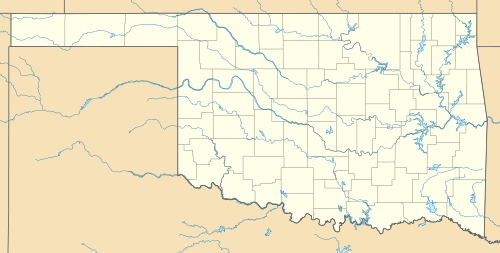Kingfisher College
|
Parker Hall, erected in 1897 | |
| Type | College |
|---|---|
| Active | September 26, 1894–1922 |
| Affiliation | Congregational church |
| President | Julius Temple House (first) |
| Dean | F. J. Titt, J. W. Scroggs |
| Students | 117 |
| Location | Kingfisher, Oklahoma, United States |
|
Kingfisher College Site | |
  | |
| Coordinates | 35°52′00″N 97°54′30″W / 35.86667°N 97.90833°WCoordinates: 35°52′00″N 97°54′30″W / 35.86667°N 97.90833°W |
| Area | 3 acres (1 ha) |
| Built | 1890 |
| NRHP Reference # | 76001566 |
| Added to NRHP | October 22, 1976[1] |
Kingfisher College was a college in Kingfisher, Oklahoma from 1895-1922.[2]
Bringing a College to Kingfisher
Founded by the Rev. Joseph Homer Parker, a Congregationalist Minister who had founded many Congregationalist churches in Canada and the Northeast U.S., and who had also founded the predecessor institution to Wichita State University. Parker, who had graduated from Middlebury College in 1869, wanted to bring the academically rigorous tradition of the liberal arts education he had received to the Midwest. Parker gave $2,500 of his own money to pay for the 120-acre (0.49 km2) campus.
Beginnings
First opened in an old hotel[3] in Kingfisher on September 2, 1895, the college was the 42nd with ties to the Congregational church in America. The class of 1896 took classes in the Beard Building, and the class of '97 graduated from the Baptist Church. Parker Hall was completed for 1897, and held class as well as dormitories inside. In the following years, Gilbert Hall, Osgood Hall, and Seay Hall were all built. Dr. Moody was president until 1915, a period in which Kingfisher continued to struggle. After subsequent President George Hatfield's six-month tenure, Dr. Tuttle took control. Tuttle would remain president until the college's close. Enrollment was increasing until World War I, when it sharply fell.[3] The college was forced to close in 1922, due to declining donations,[3] cheaper tuition at schools such as Central State Normal School,[3] and failed investments in a local flour mill, which closed due to falling wheat prices in the 1920s.[4]
Alumni
A total of 117 students graduated from Kingfisher College, 55 women and 62 men. The graduating classes never exceeded 12, including two classes of two members. The two initial years both produced only one graduate. Despite a low number of alumni, three were Rhodes Scholars and three more qualified for the prestigious honor.[3] One alumnus, Joyce C. Stearns, became an atomic scientist and worked on the Manhattan Project.[4]
After 1922 Closing
The Pentecostal Holiness Church bought the site, where King's College was open for ten years before closing. The college waited until 1976 to be added to the National Register of Historic Places.[3]
The records, degrees and library holdings were transferred to the University of Oklahoma, per a 1927 agreement by the Kingfisher Board of Trustees.[5] The Kingfisher College Chair of Philosophy of Religion and Ethics was created at OU in 1951 after a thirty-thousand dollar endowment.[5] Thirteen years later, the entire endowment fund was transferred to the University of Oklahoma.[5]
References
- ↑ National Park Service (2009-03-13). "National Register Information System". National Register of Historic Places. National Park Service.
- ↑ "National Register of Historic Places." Kingfisher County, Oklahoma. Retrieved on 5-30-2008.
- 1 2 3 4 5 6 Hanneman, Carolyn G. "Kingfisher College," Oklahoma Historical Society. Retrieved September 12, 2016.
- 1 2 Patterson, Matt (September 11, 2016). "Exhibit in Kingfisher highlights long lost Oklahoma college's legacy". NewsOK. The Oklahoman. Retrieved September 12, 2016.
- 1 2 3 "Department of Philosophy." Philosophy. University of Oklahoma. Retrieved on 5-30-2008.
